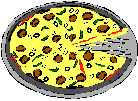Headache and Asthma Summary
 Three
million Americans are considered sensitive to sulfites by the Federal
Drug
Administration. Five percent of asthmatics must avoid sulfites
according
to the Centers for Disease Control. Some studies suggest that these
estimates
are significantly too low. Sulfites induce tissue swelling and cause
breathing
problems in asthmatics according to the National Institutes of Allergy
and
Infectious Diseases. Asthma is on the rise as reported by the American
Lung
Association. And sulfur preservatives are everywhere as demonstrated by
this
book. These are the facts. How you interpret these facts depends upon
your
frame of mind, your source of income and your background. My
interpretation
is presented below. What about my bias? I am very sensitive to
sulfites, my
source
of income is electronics and my training was at a technical college.
Three
million Americans are considered sensitive to sulfites by the Federal
Drug
Administration. Five percent of asthmatics must avoid sulfites
according
to the Centers for Disease Control. Some studies suggest that these
estimates
are significantly too low. Sulfites induce tissue swelling and cause
breathing
problems in asthmatics according to the National Institutes of Allergy
and
Infectious Diseases. Asthma is on the rise as reported by the American
Lung
Association. And sulfur preservatives are everywhere as demonstrated by
this
book. These are the facts. How you interpret these facts depends upon
your
frame of mind, your source of income and your background. My
interpretation
is presented below. What about my bias? I am very sensitive to
sulfites, my
source
of income is electronics and my training was at a technical college.
Prior to 1970, asthma rates were falling in the
United States due in part
to advances in medicine and a decline in smoking. Then asthma rates
flattened
and have risen ever since, even though medical advances continue and
smoking
is still declining. Obviously, a powerful asthma trigger or combination
of
triggers has worked its way into the American lifestyle. None of the
known
asthma triggers can be demonstrated to be both increasing and of
sufficient
scope to account for the rise in asthma rates among all ages and
classes
of Americans. None, except one: sulfites. For many good reasons, sodium
sulfites
and sulfur dioxide have become commonplace additives to our food
supply.
And, American food habits have aggravated the problem by turning toward
the
convenience foods that are most highly preserved. As a result,
asthmatics
are exposed to constant low levels of the oxides of sulfur which, for
some,
reduces their tolerance to asthma triggers. People not afflicted with
asthma
can suffer other auto-immune diseases that may be complicated by
sulfite
induced tissue swelling. I am such a person and I suffer from sulfite
headaches.
I am not talking about everyone. But, I am talking about millions of
people.
 If
you are asthmatic, I suggest you take a look at sulfur preservatives.
If
you suffer from headaches that last for days, I urge you take a close
look
at sulfites. And, if you suffer from any auto-immune or allergic
disease
that is not under control, take a look at sulfur. It’s easy to reduce
the sulfur dioxide content of your diet by simply avoiding a few foods.
Look
over the Common Foods Table in the chapter "Are You Sensitive?" Read
food
labels and avoid those listed in the Effective Sulfur Oxide Ingredient
Table
in the chapter titled "Knowing the Demons." Ask your doctor and, if
your
doctor agrees, avoid sulfur preservatives for a few weeks. If it helps,
you
will have made a tremendous discovery.
If
you are asthmatic, I suggest you take a look at sulfur preservatives.
If
you suffer from headaches that last for days, I urge you take a close
look
at sulfites. And, if you suffer from any auto-immune or allergic
disease
that is not under control, take a look at sulfur. It’s easy to reduce
the sulfur dioxide content of your diet by simply avoiding a few foods.
Look
over the Common Foods Table in the chapter "Are You Sensitive?" Read
food
labels and avoid those listed in the Effective Sulfur Oxide Ingredient
Table
in the chapter titled "Knowing the Demons." Ask your doctor and, if
your
doctor agrees, avoid sulfur preservatives for a few weeks. If it helps,
you
will have made a tremendous discovery.
Nutrition labels are of great help for people with
food intolerance, allergy
and special dietary needs. Can you imagine trying to sort through the
sulfite
maze without the help of an ingredient list? Of course, the label could
be
improved. For instance, the listing for caramel color could be expanded
to
include the class. Caramel color is produced in four classes. Classes 1
and
3 are low in sulfites while 2 and 4 are high. When I see caramel color
on
a food label, I have to assume it is highly sulfited and I don’t buy.
If the label said "sulfite-free caramel color", I would buy it. Are you
listening
manufacturers…you could increase sales.
I could also wish for the sulfur dioxide content to
be printed right on the
nutrition label. I know this is not going to happen, but I have to make
the
plea. The cost of printing sulfur dioxide numbers on the nutrition
label
would be moderate. Most manufacturers of food additives already track
sulfur
dioxide as part of the process and publish either maximum or typical
specs.
It would be a simple matter to add up the numbers for a recipe and
print
them on the label. The sulfur dioxide numbers could be used directly or
they
could be slightly reduced to better represent effective sulfur oxide as
defined
in this book. The most trouble would arise for products that used
additives
from different sources since this would increase quality control
burdens.
The burden aside, printing numbers on a label would put pressure on all
manufacturers to reduce the oxides of sulfur to the lowest possible
levels.
If this reduced any portion of our 15 billion dollar asthma cost, it
might
be worth the effort.
 If
I were king, I would conduct a study of a group of asthma and headache
sufferers.
I would divide them into three categories depending on their triggers:
sulfite,
other and unknown. I would ask half the group to eat normally for one
month
and ask half to minimize their intake of sulfur preservatives. Then the
groups
could switch. Asthma and headache problems during these periods could
be
recorded and analyzed. If minimizing sulfur preservatives reduced
overall
asthma problems by just 1%, that could save 150 million dollars per
year.
A 10% asthma reduction could save 1.5 billion dollars. Similar
reductions
in headache problems could save up to 5 billion dollars. And, we
haven't
even touched upon quality of life issues. Yes, if I were king, I would
definitely
conduct a study of the effects of low level exposure to the oxides of
sulfur.
If
I were king, I would conduct a study of a group of asthma and headache
sufferers.
I would divide them into three categories depending on their triggers:
sulfite,
other and unknown. I would ask half the group to eat normally for one
month
and ask half to minimize their intake of sulfur preservatives. Then the
groups
could switch. Asthma and headache problems during these periods could
be
recorded and analyzed. If minimizing sulfur preservatives reduced
overall
asthma problems by just 1%, that could save 150 million dollars per
year.
A 10% asthma reduction could save 1.5 billion dollars. Similar
reductions
in headache problems could save up to 5 billion dollars. And, we
haven't
even touched upon quality of life issues. Yes, if I were king, I would
definitely
conduct a study of the effects of low level exposure to the oxides of
sulfur.
Throughout this book, sulfites and sulfur dioxide
are accused of heinous
crimes: causing headaches, triggering asthma, creating mayhem. At
times,
I even refer to them as Sulfur Demons. Of course, there is nothing evil
about
sulfites. They are just chemicals. And, there is nothing sinister about
the
companies that produce or use sulfites. They are just trying to make
the
best products they can. For most of America, they do a great job. The
food
looks good, tastes great and lasts long enough to get from the field to
your
kitchen table. For people like me with an exaggerated metabolism, it’s
just tough luck. I must be wise enough to know what to avoid, carry a
remedy
if needed and not get upset about it. There aren’t many real monsters
out there, just people like you and me trying to get by the best we
can.
If you have questions about sulfites, I am happy to answer
email
from "nosulfites@aol.com".
 Three
million Americans are considered sensitive to sulfites by the Federal
Drug
Administration. Five percent of asthmatics must avoid sulfites
according
to the Centers for Disease Control. Some studies suggest that these
estimates
are significantly too low. Sulfites induce tissue swelling and cause
breathing
problems in asthmatics according to the National Institutes of Allergy
and
Infectious Diseases. Asthma is on the rise as reported by the American
Lung
Association. And sulfur preservatives are everywhere as demonstrated by
this
book. These are the facts. How you interpret these facts depends upon
your
frame of mind, your source of income and your background. My
interpretation
is presented below. What about my bias? I am very sensitive to
sulfites, my
source
of income is electronics and my training was at a technical college.
Three
million Americans are considered sensitive to sulfites by the Federal
Drug
Administration. Five percent of asthmatics must avoid sulfites
according
to the Centers for Disease Control. Some studies suggest that these
estimates
are significantly too low. Sulfites induce tissue swelling and cause
breathing
problems in asthmatics according to the National Institutes of Allergy
and
Infectious Diseases. Asthma is on the rise as reported by the American
Lung
Association. And sulfur preservatives are everywhere as demonstrated by
this
book. These are the facts. How you interpret these facts depends upon
your
frame of mind, your source of income and your background. My
interpretation
is presented below. What about my bias? I am very sensitive to
sulfites, my
source
of income is electronics and my training was at a technical college.
 If
you are asthmatic, I suggest you take a look at sulfur preservatives.
If
you suffer from headaches that last for days, I urge you take a close
look
at sulfites. And, if you suffer from any auto-immune or allergic
disease
that is not under control, take a look at sulfur. It’s easy to reduce
the sulfur dioxide content of your diet by simply avoiding a few foods.
Look
over the Common Foods Table in the chapter "Are You Sensitive?" Read
food
labels and avoid those listed in the Effective Sulfur Oxide Ingredient
Table
in the chapter titled "Knowing the Demons." Ask your doctor and, if
your
doctor agrees, avoid sulfur preservatives for a few weeks. If it helps,
you
will have made a tremendous discovery.
If
you are asthmatic, I suggest you take a look at sulfur preservatives.
If
you suffer from headaches that last for days, I urge you take a close
look
at sulfites. And, if you suffer from any auto-immune or allergic
disease
that is not under control, take a look at sulfur. It’s easy to reduce
the sulfur dioxide content of your diet by simply avoiding a few foods.
Look
over the Common Foods Table in the chapter "Are You Sensitive?" Read
food
labels and avoid those listed in the Effective Sulfur Oxide Ingredient
Table
in the chapter titled "Knowing the Demons." Ask your doctor and, if
your
doctor agrees, avoid sulfur preservatives for a few weeks. If it helps,
you
will have made a tremendous discovery.
 If
I were king, I would conduct a study of a group of asthma and headache
sufferers.
I would divide them into three categories depending on their triggers:
sulfite,
other and unknown. I would ask half the group to eat normally for one
month
and ask half to minimize their intake of sulfur preservatives. Then the
groups
could switch. Asthma and headache problems during these periods could
be
recorded and analyzed. If minimizing sulfur preservatives reduced
overall
asthma problems by just 1%, that could save 150 million dollars per
year.
A 10% asthma reduction could save 1.5 billion dollars. Similar
reductions
in headache problems could save up to 5 billion dollars. And, we
haven't
even touched upon quality of life issues. Yes, if I were king, I would
definitely
conduct a study of the effects of low level exposure to the oxides of
sulfur.
If
I were king, I would conduct a study of a group of asthma and headache
sufferers.
I would divide them into three categories depending on their triggers:
sulfite,
other and unknown. I would ask half the group to eat normally for one
month
and ask half to minimize their intake of sulfur preservatives. Then the
groups
could switch. Asthma and headache problems during these periods could
be
recorded and analyzed. If minimizing sulfur preservatives reduced
overall
asthma problems by just 1%, that could save 150 million dollars per
year.
A 10% asthma reduction could save 1.5 billion dollars. Similar
reductions
in headache problems could save up to 5 billion dollars. And, we
haven't
even touched upon quality of life issues. Yes, if I were king, I would
definitely
conduct a study of the effects of low level exposure to the oxides of
sulfur.